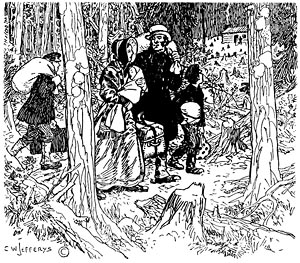| Fact & Fantasy: A History of Tavistock & District | Agriculture - Page 61 |
|
|
AGRICULTURE: Down on the Farm Principles and traditions of pioneering were the solid basis of Canadian agriculture a century ago. Canadian farmers today are pioneers as well, not so much in land settlement, as in new ideas and techniques, with increased production and the acceptance of a new challenge at the hands of our economists. Agriculture, as Canada's leading industry, plays a vital role in our national livelihood. No amount of retrospection could adequately portray the efforts and hopes in developing our vast farmlands. A sketchy commentary on our small area is all that we can attempt in these reviews. 
At the time of Confederation, farmers were relatively self-sufficient and were concerned mainly with production for family needs. Today the farmer operates as part of a highly integrated society, in which thirty-nine persons are supplied with food and fibre by each farm worker. One hundred years ago more Canadians were concerned in farming than in any other occupation. The census of 1871 showed a population 80% rural. Today the area of an average Ontario farm is more than 3-1/2 times that of an 1867 one and still greater in terms of improved land. Through years of experience, farmers in a given area have learned that by co-operating with Nature they can produce certain crops and livestock more profitably than others. The Tavistock area is one of adequate rainfall throughout the growing season. Pastures are excellent, good hay crops can be grown, but a short, cool growing season has made it difficult to mature corn, until the introduction of early maturing hybrid varieties. Large industrial cities nearby create a ready market for dairy and livestock products. For many years Tavistock has been the centre of both domestic and export rutabaga production for which soil type and climate condition are critical. In 1967 the Ontario Department of Agriculture, through the Junior Farmers of the province, recognized Century Farms - approximately 3/4 of which are in the Tavistock area, in Perth and Oxford counties. These have been the strong hold of Ontario agriculture, farms which have been in the same family for three, four and even five generations. These are the homesteads that have paid for themselves with each transfer, have provided a living four countless people, have provided the means for education and started the careers of many urbanites, have paid for buildings and homes and have given rise to multitudes of happy memories. On these farms still stand the houses and barns, the symbols of our pioneers, still sound and full of the character of their builder-tenants. These are the family-operated farms we take for granted. These are the farms that started with a self-sufficient colonist, who produced almost everything he used. This phase of history culminates in the present farmer whose horse-power is bought from factories and whose feed for livestock is supplemented by the scientist in a laboratory, producing such fabulous substances as antibiotics and hormones. His family farm must be a costly, efficient, geared complex of fields, barns and equipment, all of it gluttonously hungry of capital and efficient management. Though differing in detail yet parallel in principle, is the story of a typical settler who established a farm in East Zorra Township. Born in Germany in 1827 Conrad Stock immigrated to America in 1841. He landed in New York, sailed up the Hudson River to Albany, then came by Erie Barge Canal and rail to Rochester and finally by steamer across Lake Ontario to Hamilton. His journey continued through Preston, Berlin and ended in North Easthope, where for five years he helped many newcomers to clear the land. In the fall of 1849 he bought a piece of virgin forest at Lot 31,Concession 16, East Zorra, married in 1850 and moved onto the property the same year. The original house was built of logs, hewn by hand from trees felled by axe, with additions for grain storage and stabling for his ox-team. As land clearing continued, logs and brush were piled in an east-west direction and burned to take advantage of the prevailing winds. Seed grain was broadcast between the protruding stumps and cultivated with a homemade V-type harrow and harvested with a hand-swept cradle. Grain was threshed with a flail and winnowed by sifting through an open-weave basket, so that the heavy grain fell to the floor, as the wind blew the chaff aside. As time went on, he bred and fed his own "horsepower", he saved seed from the best of his stalks, he fertilized his fields with the manure from his stock. His wife carded and spun the wool he sheared from his sheep in the spring, made clothing for their growing family. She stored her cellar with fruit and food for the long winter ahead. She heated the home from high piles of cordwood. For medicine she had sulphur, ginger, yarrow and peppermint tea, goose-grease and coal-oil and even skunk-oil. Together the young couple accepted Nature as an ally for the soil and the sun and the rain nourished their crops. Together they fought frost and drought, flood and insect plague, and droves of wild pigeons. Together they fashioned their independence and security. |
|
|
| PREVIOUS | TABLE OF CONTENTS | NEXT |